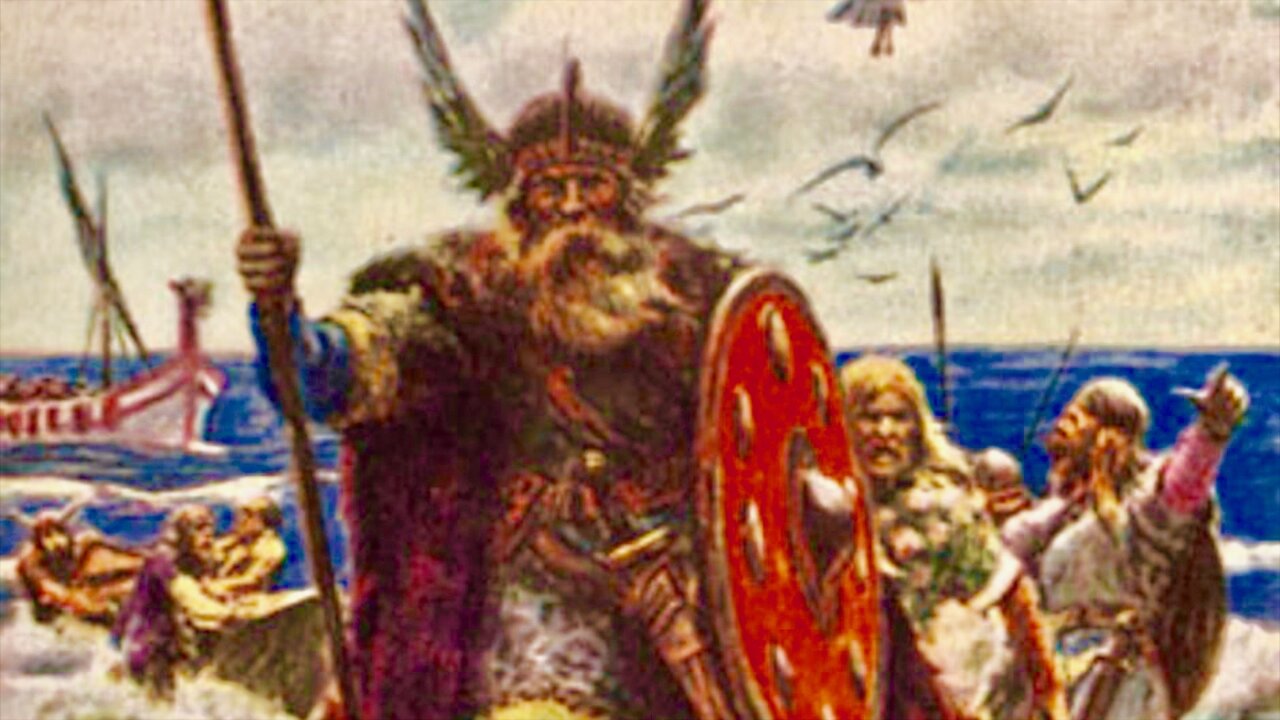Premium Only Content

Civilizations that Possibly Discovered America before Columbus
In 1492, Columbus sailed the ocean blue—and then he discovered America. That’s the story we all grew up with, but it’s now common knowledge that the Vikings beat Christopher Columbus to the Americas by around 500 years...They might not have been the only ones. From 1368–1644, China was ruled by the Ming Dynasty. As Europe was becoming dominated by ships and sails, China was also encouraging naval exploration, and one expedition may have led to America. The theory—which has been dubbed the “1421 theory,” the year the Chinese supposedly made landfall—was popularized by British amateur historian Gavin Menzies posits that during the 70 years before Columbus reached the New World, the Chinese were ruling major American tribes and interbreeding with the natives.
There are multiple theories that ancient Semitic peoples visited the Americas. One formerly popular theory suggests that the Phoenicians were responsible for establishing the major pre-Columbian Native American empires. This theory is heavily associated with the legend of Votan, a mythological figure who allegedly founded the first city of the New World in 1000 B.C. Curiously, this critically important figure is referenced only in European texts. Most of the archaeological evidence in support of the Phoenician theory has been dismissed as fake, but there is an intriguing Carthaginian coin that may feature a map of the world. The Carthaginians were descendants of the Phoenicians, so their knowledge of the New World would support the theory.
A more widespread theory concerns the Israelites. According to the Book of Mormon, three Israelite groups—the Nephites, Lamanites, and Mulekites—settled the Americas with a non-Israelite group called the Jaredites. They established major cities, wrote extensively in Hebrew and Egyptian, and imported flora and fauna from the Old World. These groups together were also said to be the ancestors of the Native Americans. Nothing in archaeology or genetic testing has substantiated any of these claims, and none of the groups are mentioned outside of Latter-day Saints literature, but because the Book of Mormon is considered divine, many believers accept the claims as fact.
The most compelling evidence comes from a Chinese map that was supposedly drawn in 1408 and depicts the entire world, including the American supercontinent. Many historians have dismissed this map as a Chinese copy of a 17th-century Jesuit map, mostly because China itself is so poorly detailed.
The Knights Templar were dissolved in the 14th century on charges of heresy, though many historians believe the real reason for the persecution was jealousy. Thanks to their banking system, the order of warrior monks was remarkably well off. Of course, being burned at the stake does tend to put a damper on business.
During the fight against persecution, some knights supposedly escaped to Scotland, where they received help from Henry Sinclair, Prince of Orkney Islands. In 1393, Sinclair had carried out a survey of Greenland through a Venetian admiral. Now, in 1398, he was ready to lead an expedition to the New World by following old Viking routes. Twelve ships carried Sinclair and hundreds of Templar refugees to Nova Scotia, Canada, where the knights allegedly hid their treasure. Sinclair is then said to have explored as far south as present-day Massachusetts.
Sinclair and the refugees may have assimilated with the natives instead of returning to Scotland. One outlandish claim is that the alleged gnostic beliefs of the Templar had a massive influence on Native American religion, while another states that the founding fathers were influenced by Templar teachings. The cited evidence includes a portrait of a medieval knight on a stone in Westford, Massachusetts and an old tower in Newport, Rhode Island that looks fairly European. The remains of an old castle, a cannon, and a stone wall in Nova Scotia are supposedly further evidence of the theory.
The empire of Mali was a West African superpower in the late Middle Ages. Mali was stupendously wealthy, and its leader, Mansa Musa, was the richest man of all time. So mighty was his economic power that when he visited Egypt in 1324, he crashed the Egyptian gold market.
While he was wreaking financial havoc on Egypt, Musa also told the story of his predecessor, Mansa Abubakari II. Abubakari had supposedly commissioned a voyage to the end of the Atlantic Ocean.
He and his fleet never returned, and some speculated that he landed in Brazil in 1312. When Columbus arrived over 100 years later, he allegedly encountered African traders and spears tipped in African gold. The giant stone carvings of heads found in southern Mexico, called the Olmec Heads, have also been cited as evidence of Africans in pre-Columbian America. The Olmec are regarded as one of the first civilizations in Mexico and their stone heads display African features.
Music: Bulls Of Poseidon (More Kicks Mix) by Dhruva Aliman
Amazon- https://amzn.to/2MbZ3TF
https://music.apple.com/us/artist/dhruva-aliman/363563637
https://dhruvaaliman.bandcamp.com/album/snooper
http://www.dhruvaaliman.com/
Spotify - https://open.spotify.com/artist/5XiFCr9iBKE6Cupltgnlet
#history
#vikings
#interestingfacts
-
 48:29
48:29
Seeker Land
1 month agoSnowball Earth ~ The Cryogenian Ice Age That Birthed Complex Life On Earth
1721 -
 1:21:55
1:21:55
Kim Iversen
9 hours agoMultiple States To BAN mRNA Vaccines | They Want to Make Protesting Illegal, Here's How
59K75 -
 7:34:25
7:34:25
Dr Disrespect
16 hours ago🔴LIVE - DR DISRESPECT - WARZONE - IMPOSSIBLE TRIPLE THREAT CHALLENGE
191K27 -
 1:02:45
1:02:45
Tundra Tactical
6 hours ago $14.38 earned🛑 KASH PATEL NEW ATF DIRECTOR??? Breaking News!!!! 🛑
50.3K7 -
 4:31:10
4:31:10
I_Came_With_Fire_Podcast
16 hours agoMy EURO Divorce | HOGG with a side of PAC | Foreign FUNDS Fudged
30.1K2 -
 37:44
37:44
Glenn Greenwald
13 hours agoGlenn On Tearing Down the Military Industrial Complex, Exposing Pro-Israel Indoctrination, and More | SYSTEM UPDATE #411
106K120 -
 4:04:20
4:04:20
Nerdrotic
12 hours ago $49.47 earnedAmazon Takes 007! Hollywood is Lost, Disney Cancels WHO? | Friday Night Tights 342 /w ItsAGundam
167K39 -
 43:27
43:27
Tucker Carlson
11 hours agoRay Dalio: America’s Hidden Civil War, and the Race to Beat China in Tech, Economics, and Academia
161K184 -
 56:56
56:56
Candace Show Podcast
12 hours agoEXCLUSIVE: Taylor Swift Will Be Deposed. | Candace Ep 150
187K147 -
 1:03:52
1:03:52
IsaacButterfield
9 hours ago $4.34 earnedRepublican Vs 25 Transgender Activists | Jewish Outrage | Lizzo Loses All the Weight
55.7K14